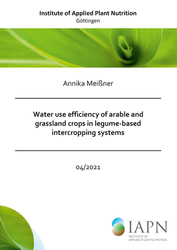| Departments | |
|---|---|
| Book Series (96) |
1378
|
| Nachhaltigkeit |
3
|
| Gesundheitswesen |
1
|
| Humanities |
2364
|
| Natural Sciences |
5406
|
| Mathematics | 229 |
| Informatics | 319 |
| Physics | 980 |
| Chemistry | 1363 |
| Geosciences | 131 |
| Human medicine | 243 |
| Stomatology | 10 |
| Veterinary medicine | 108 |
| Pharmacy | 147 |
| Biology | 835 |
| Biochemistry, molecular biology, gene technology | 121 |
| Biophysics | 25 |
| Domestic and nutritional science | 45 |
| Agricultural science | 1004 |
| Forest science | 201 |
| Horticultural science | 20 |
| Environmental research, ecology and landscape conservation | 148 |
| Engineering |
1793
|
| Common |
98
|
|
Leitlinien Unfallchirurgie
5. Auflage bestellen |
|
Advanced Search
Water use efficiency of arable and grassland crops in legume-based intercropping systems (Volume 4) (English shop)
Annika Meißner (Author)Preview
Extract, PDF (270 KB)
Table of Contents, PDF (210 KB)
Legume-based intercropping systems have the potential for a more efficient use of water resources. This depends on various factors such as environmental conditions and genotypic characteristics. Therefore, several genotypes of legumes and non-legumes of arable, grassland and woody crops were tested comparing intercropping and pure stands under both greenhouse and field conditions. Greenhouse experiments with winter faba bean and winter wheat under water deficit revealed genotypic differences in the suitability for intercropping as well as effects on the microbial community. Field experiments with direct and remote measurements showed that including legumes in arable and grassland low-input systems improves water use efficiency and productivity in comparison to pure non-legumes. The grassland mixing partners perennial ryegrass and chicory had additional effects. Furthermore, arable intercropping reduced nitrous oxide emissions compared to fertilized wheat stands. From the consolidated results, some winter faba bean and white clover genotypes could be identified for further breeding for intercropping systems. In summary, intercropping with legumes improves the water use efficiency and the general performance and sustainability of the agro-ecosystem.
| ISBN-13 (Hard Copy) | 9783736974470 |
| ISBN-13 (eBook) | 9783736964471 |
| Final Book Format | A5 |
| Language | English |
| Page Number | 286 |
| Lamination of Cover | matt |
| Edition | 1. |
| Book Series | Institute of Applied Plant Nutrition - Göttingen |
| Volume | 4 |
| Publication Place | Göttingen |
| Place of Dissertation | Göttingen |
| Publication Date | 2021-06-14 |
| General Categorization | Dissertation |
| Departments |
Agricultural science
Plant production |
| Keywords | Wassernutzungseffizienz, water use efficiency, Trockenstress, drought stress, Trockenstresstoleranz, drought tolerance, Wassermangel, water deficit, Wiederbewässerung, re-irrigation, Gemengeanbau, intercropping, Mischanbau, mixed cropping, Reinsaat, pure stand, Monokultur, monoculture, Leguminose, legume, Acker, arable land, Grasland, grassland, Ackerbohne, faba bean, Weißklee, white clover, Weizen, wheat, Deutsches Weidelgras, perennial ryegrass, Zichorie, chicory, Genotyp, genotype, Gewächshaus, greenhouse, Feld, field, Stickstoffdünger, nitrogen fertilizer, Physiologie, physiology, Prolin, proline, Relativer Wassergehalt, relative water content, Gaswechsel, gas exchange, Assimilation, assimilation, Evapotranspiration, evapotranspiration, Kohlenstoffisotopendiskriminierung, carbon isotope discrimination, Bakterielle Gemeinschaft, bacterial community, Blattendosphäre, leaf endosphere, Mikrobielle Diversität, microbial diversity, Entomopathogener Pilz, entomopathogenic fungus, Treibhausgasemission, greenhouse gas emission, Lachgas nitrous oxide, Multikopter, multicopter, Drohne, drone, Fernerkundung, remote sensing, NDVI, NDVI, Thermographie, thermal imaging, Oberflächentemperatur, surface temperature |
| URL to External Homepage | https://www.iapn.de/ |
Rezension
European Journal of Agronomy, Crop Journal, Journal of Agronomy and Crop Science, Crop and Pasture Science, Agronomy








